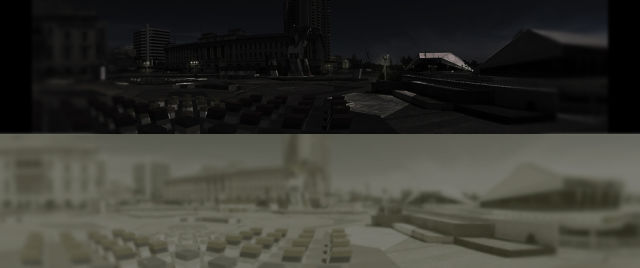
The above photos were made with the following in mind:
- Cats have a visual field of 200 degrees compared to humans 180 degrees.
- Peripheral vision for humans is 20 degrees each side. This is represented by the blurriness.
- Peripheral vision for cats is 30 degrees each side. This is represented by the blurriness.
- Cats can see 6-8 times better in dim light than humans due the high number of rods and because of their elliptical pupil, large cornea and tapetum.
- What a normal human can see as unblurred and sharp at 100-200 feet, a cat would have to view from 20 feet (a cat's visual acuity is between 20/100 to 20/200).
- Cats were originally thought to be dichromats (like dogs and protanopic humans). They have been found to have peaks at 450-454 nm and 550-561 nm (blue-violet and green-yellow, essentially). That said, there is some research out there that suggests cats may also have a third cone type that peaks at 500-520 nm (green area). This would indicate that they are trichromats, but not in the human sense (the cones aren’t as spread out and all fall in the violet-yellow range). Protanopic humans really only see blues and yellows (red-green color blind), so cats are probably like that, but with some green thrown in from that third cone type.
- Our retinas have many more cones than cats, especially in the area of the fovea (which is all cones and no rods). This gives us fantastic day vision with lots of vibrant colors and excellent, detailed resolution. Dogs and cats have many more rods, which enhances their ability to see in dim light and during the night. They have no fovea, but an “area centralis” that, though has more cones than other areas of the retina, still has more rods than cones. The increase in rods also enhances their “refresh rate”, so that they can pick up movements much faster (very helpful when dealing with small animals that change direction very quickly during a chase). These differences also help them to have great night vision, an excellent ability to pick up and follow quick movements, but at the cost of less vibrant color, with less detailed resolution. Interestingly, this also means that humans have the ability to see very slowly moving objects at speeds 10 times slower than cats (that is to say that we can see very slow things move that would not appear to be moving to a cat).
mydeals.com/blog/what-do-cats-see/post



mydeals.com/blog/what-do-cats-see/post